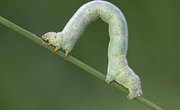There's no insect specifically known as the pine tree caterpillar, but there are certain caterpillar pests that plague pine trees. For instance, if you find clusters of inch-long green, yellow or black caterpillars marked with stripes or spots eating the needles of your pine trees, they likely are the larvae of pine sawflies, the most common and serious pine pest. Other caterpillar pests target pine trees, including pine tip caterpillars, webworms and bagworms.
Pine Sawflies
The pine sawfly is a type of solitary wasp that occurs over much of the United States. The two major species are Diprion similes and Neodiprion sertifer. The female sawfly uses a sawlike abdominal plate to slice open pine needles so she can lay one or two eggs in each needle. She lays eggs in clusters and when the larvae hatch, they tend to feed together in clusters, devouring groups of needles. They feed heavily on mature needles in late June and again in late August. When mature, the caterpillars are about an inch long. They drop to the ground and burrow in to pupate over winter. Adults emerge in spring.
Pine Tip Caterpillars
Pine tip caterpillars are moth larvae. Two major species are Rhyacionia frustrana, which occurs mainly in the eastern United States, and Rhyacionia neomexicana, occurring in the western states. They hide inside the new growing tips of pine branches and feed on the tender tips until the tips turn brown and die. The caterpillars at maturity drop to the ground and burrow down to spend the winter as a pupa, emerging as an adult in spring. Although pine tip caterpillar attacks rarely kill the host tree, they can stunt tree growth and alter the shape.
Webworms and Bagworms
Pine webworms (Pococera robustella) form globular tents on the ends of pine branches that house anywhere from 2 to 24 caterpillars. These tents become full of caterpillar excrement and dried-up pine needles. The caterpillars are about 5/8 inch long, with yellowish heads on a yellow-brown body with dark brown longitudinal stripes. Pine bagworms (Thyridopteryx ephemeraeformis) are solitary caterpillars that live in conical nests about 2 inches long that resemble little pine cones. These moth laevae feed on needles, but bagworms may also eat bark of young twigs. Outbreaks of webworms and bagworms can seriously defoliate pine trees.
Caterpillar Control
Caterpillar populations normally are kept in check by natural insect and animal enemies, disease, hunger and adverse weather. But population explosions can occur when natural controls don’t produce sufficient caterpillar mortality. If there are only a small number of caterpillars, you can pick them off by hand, shake them off the tree or prune afflicted limbs. But heavy infestations may require use of insecticides. Pesticides effective against caterpillars include:
- acephate
- azadiractin
- bifenthrin
- carbaryl
- cyfluthrin
- esfenvalerate
- permethrin
- spinosad
These products are sold under various brand names.
References
About the Author
Herb Kirchhoff has more than three decades of hands-on experience as an avid garden hobbyist and home handyman. Since retiring from the news business in 2008, Kirchhoff takes care of a 12-acre rural Michigan lakefront property and applies his experience to his vegetable and flower gardens and home repair and renovation projects.
